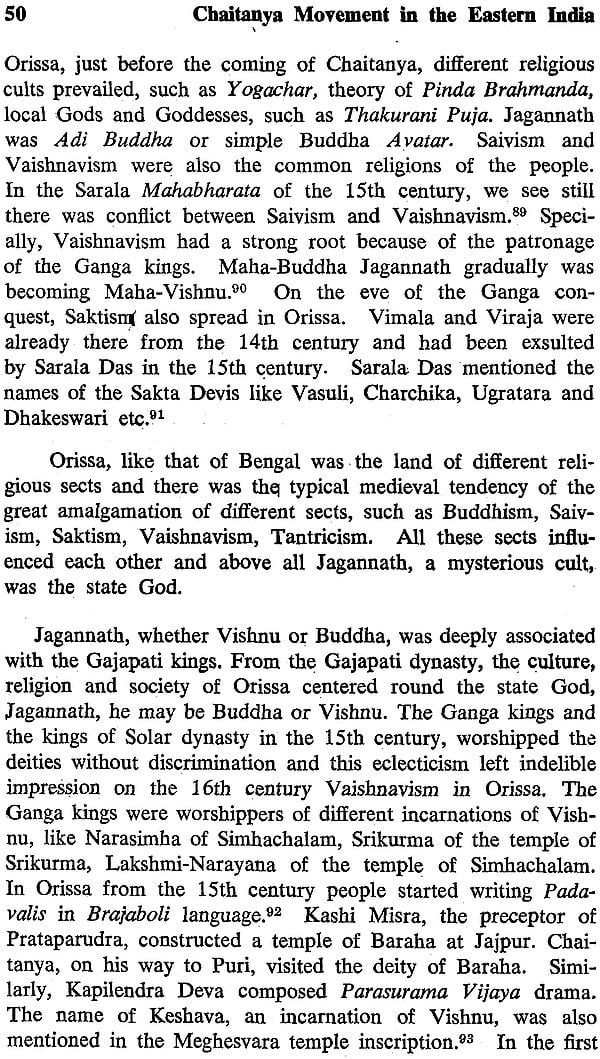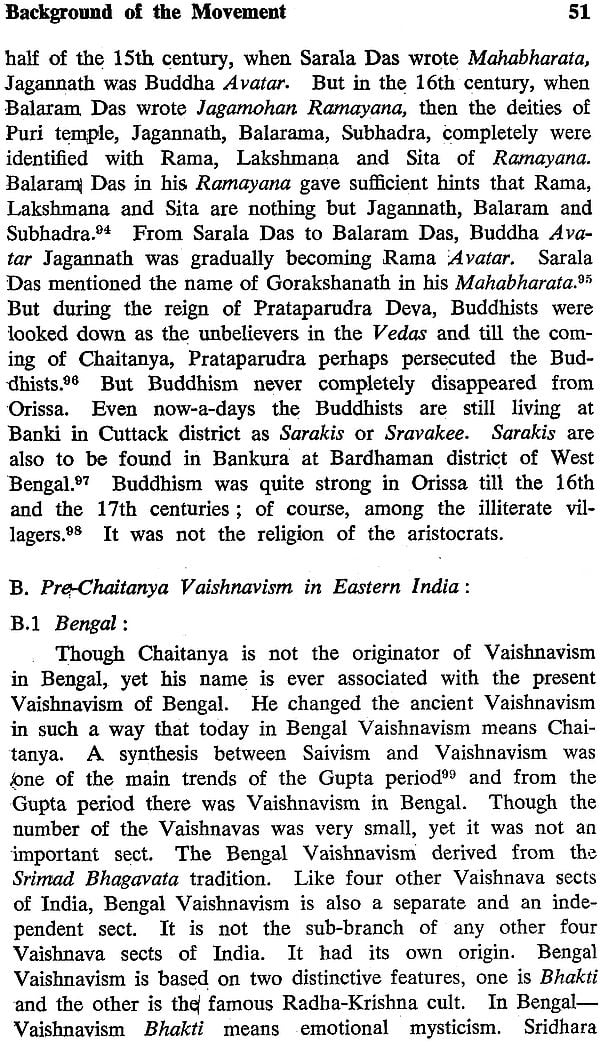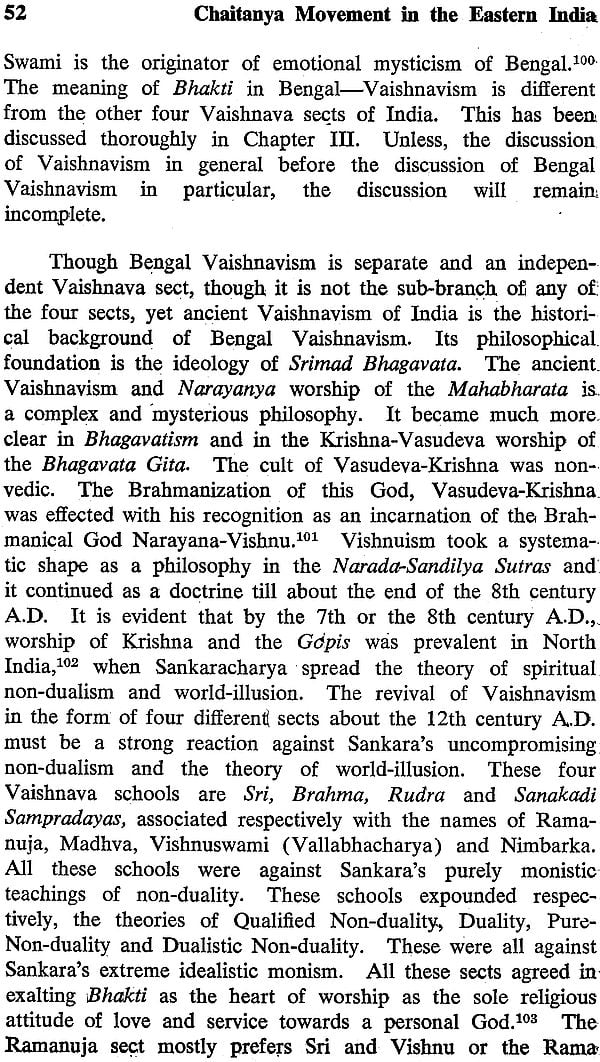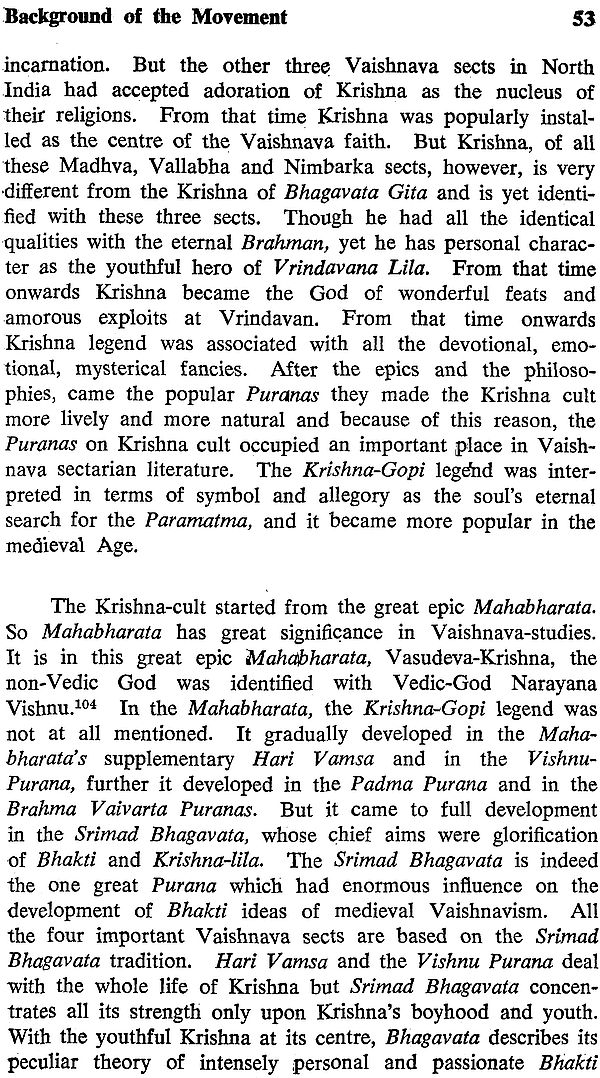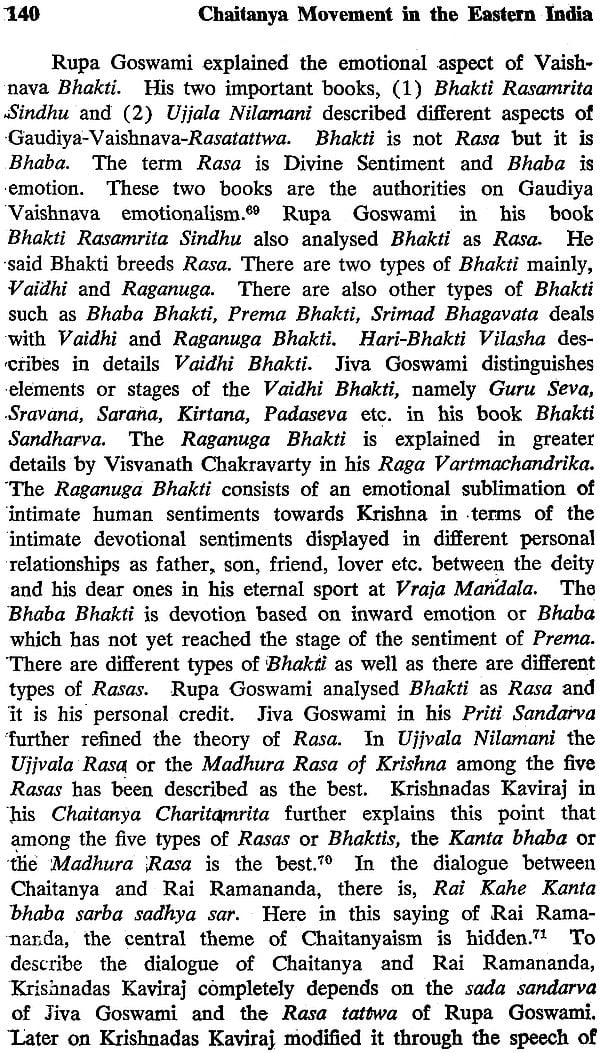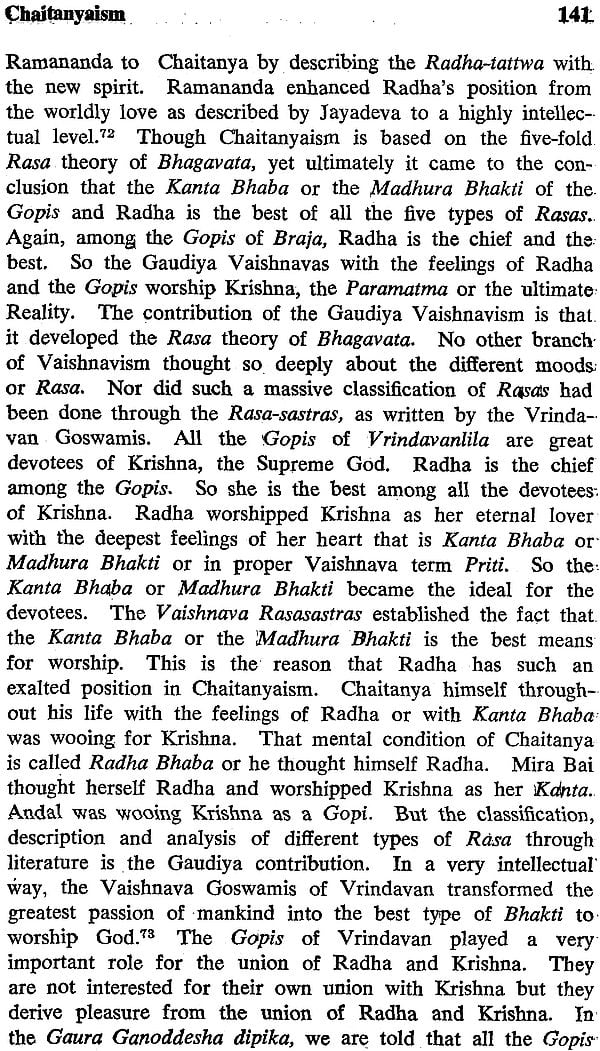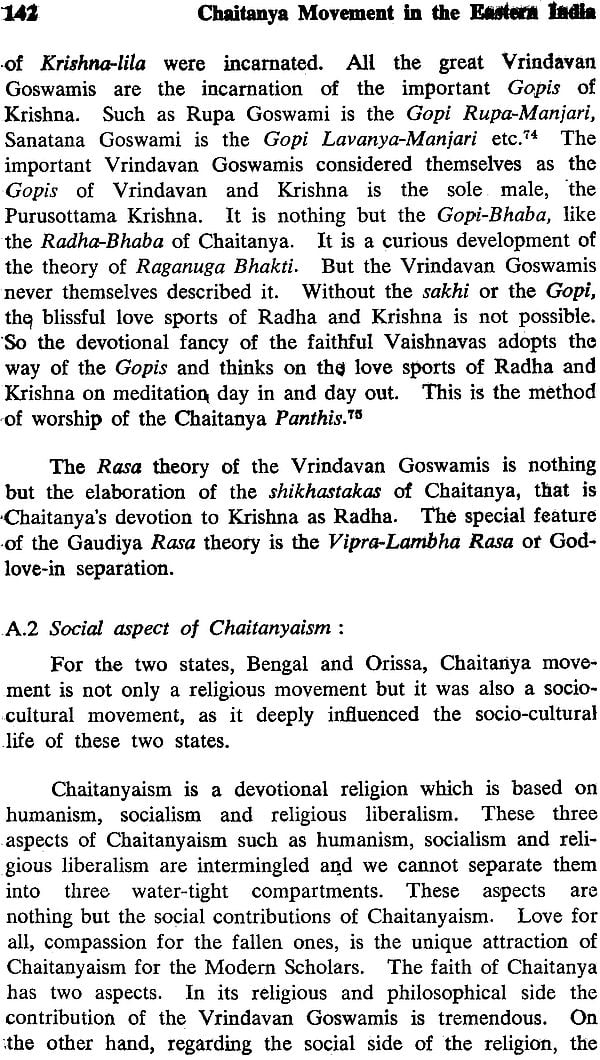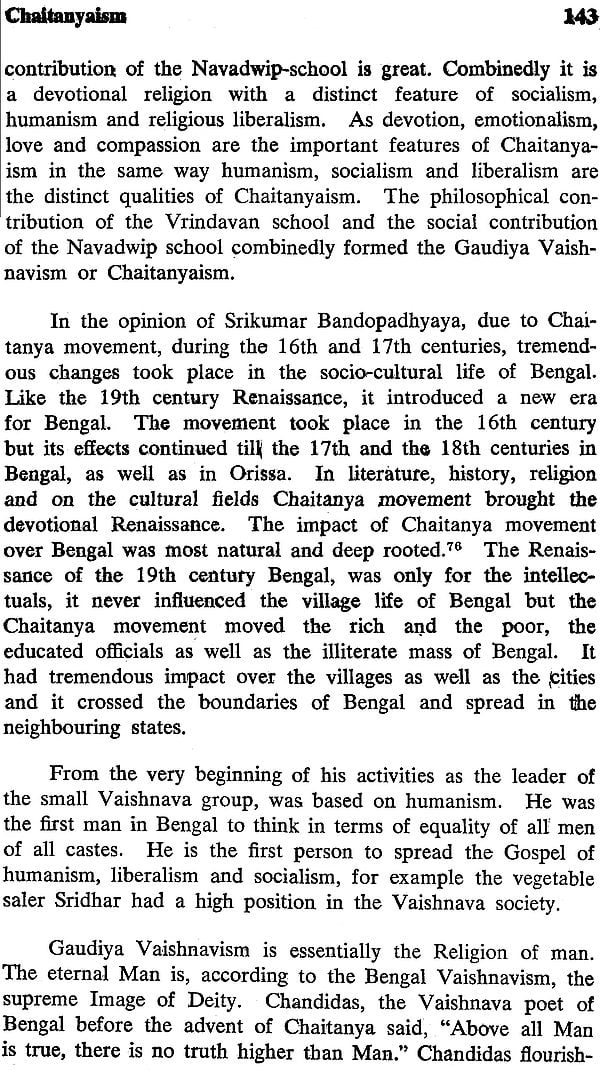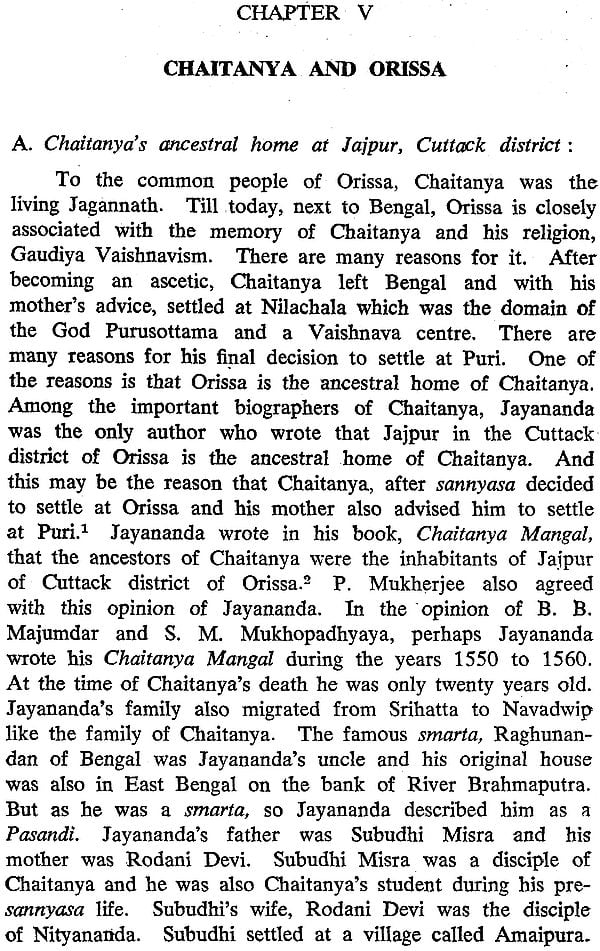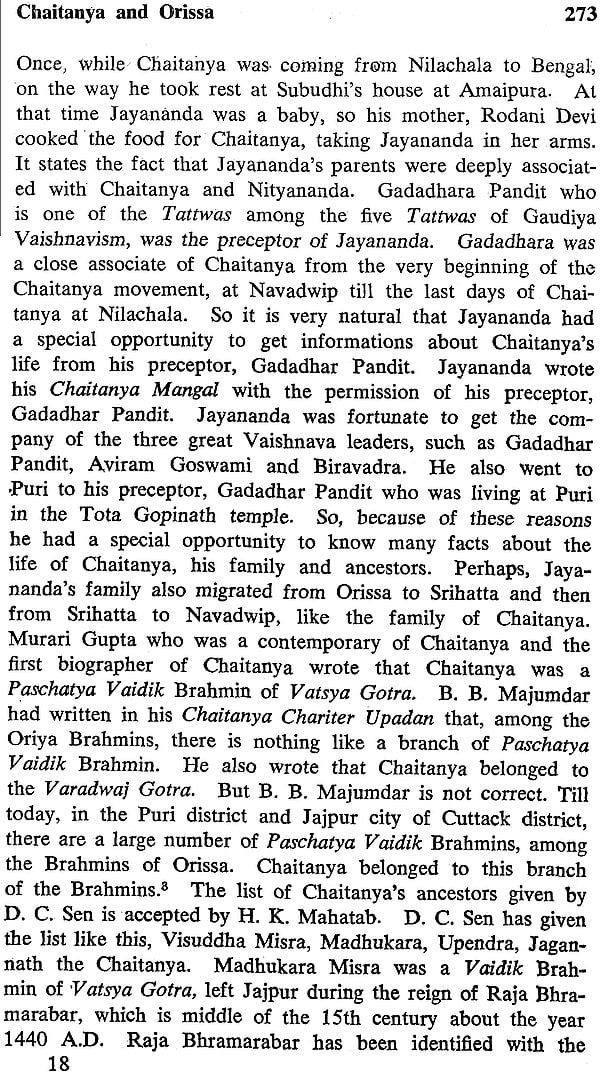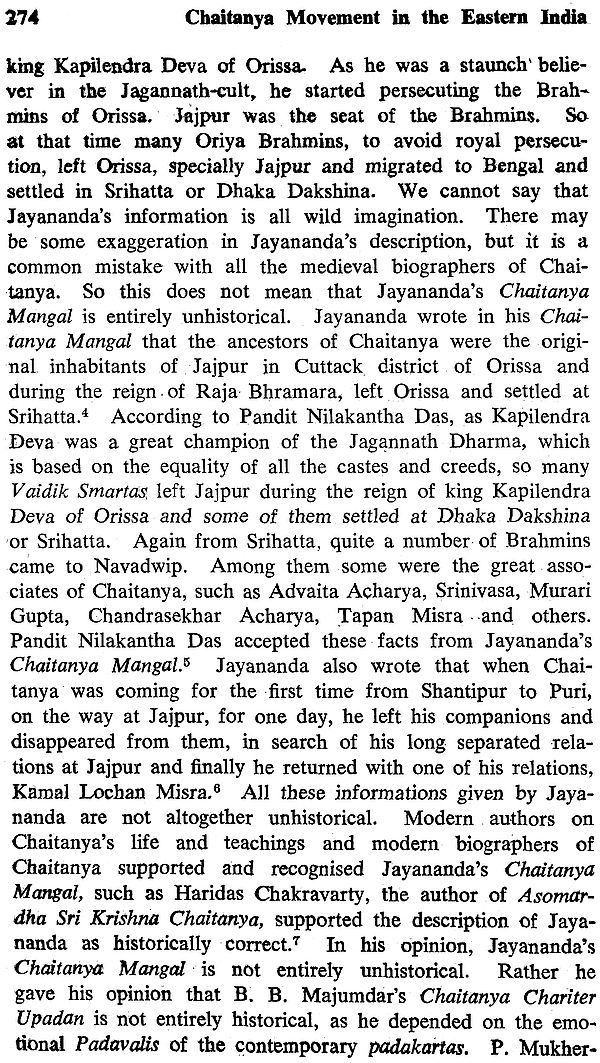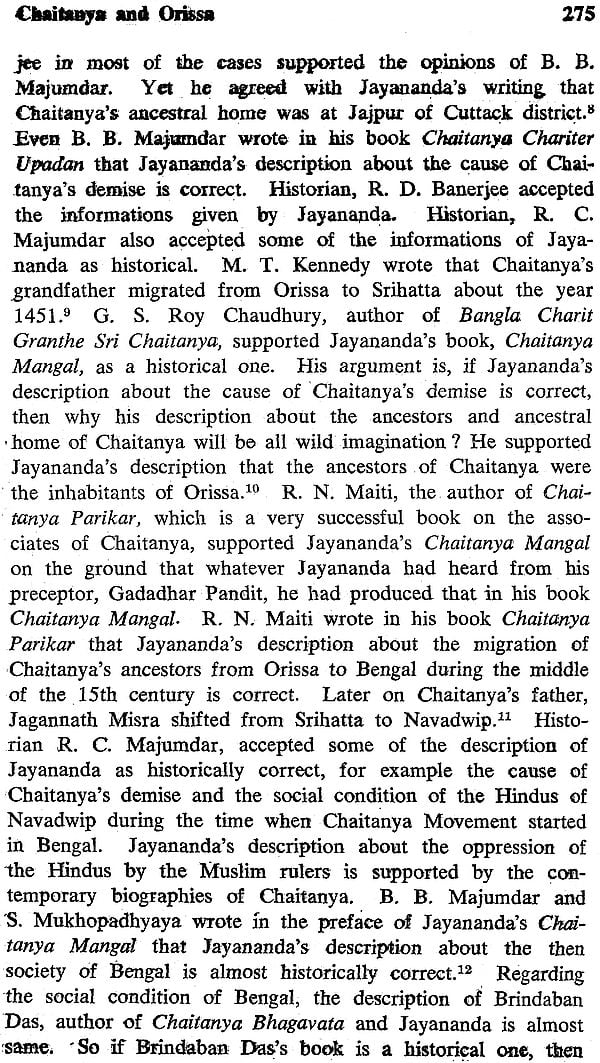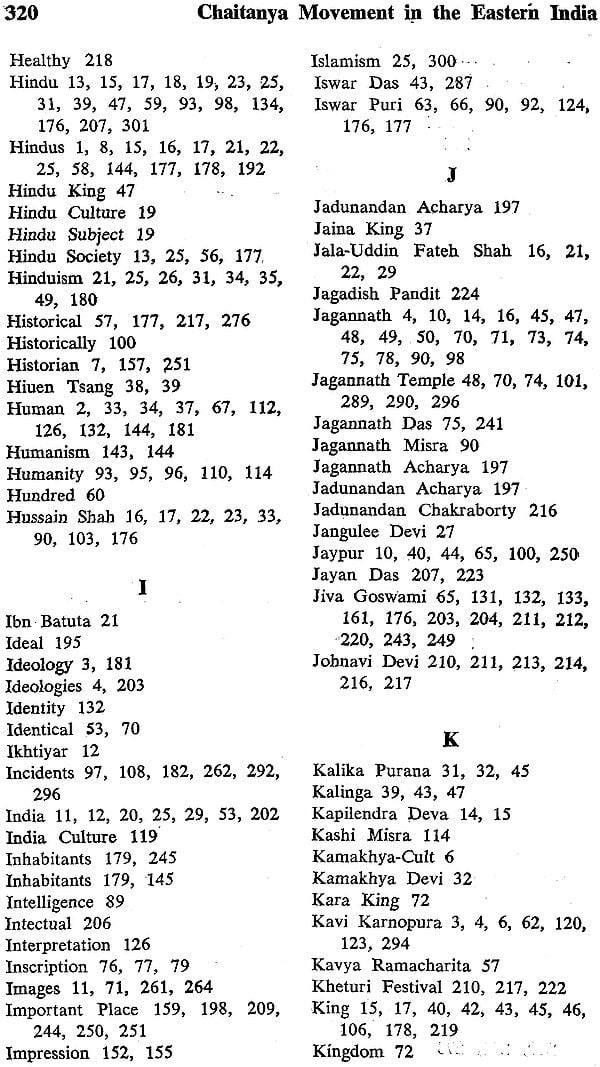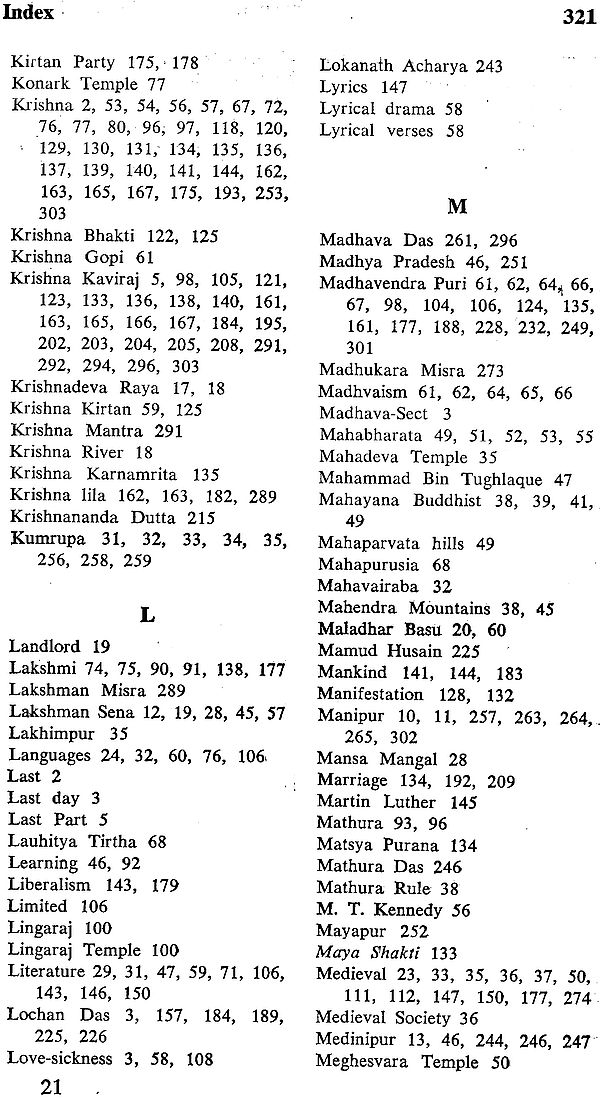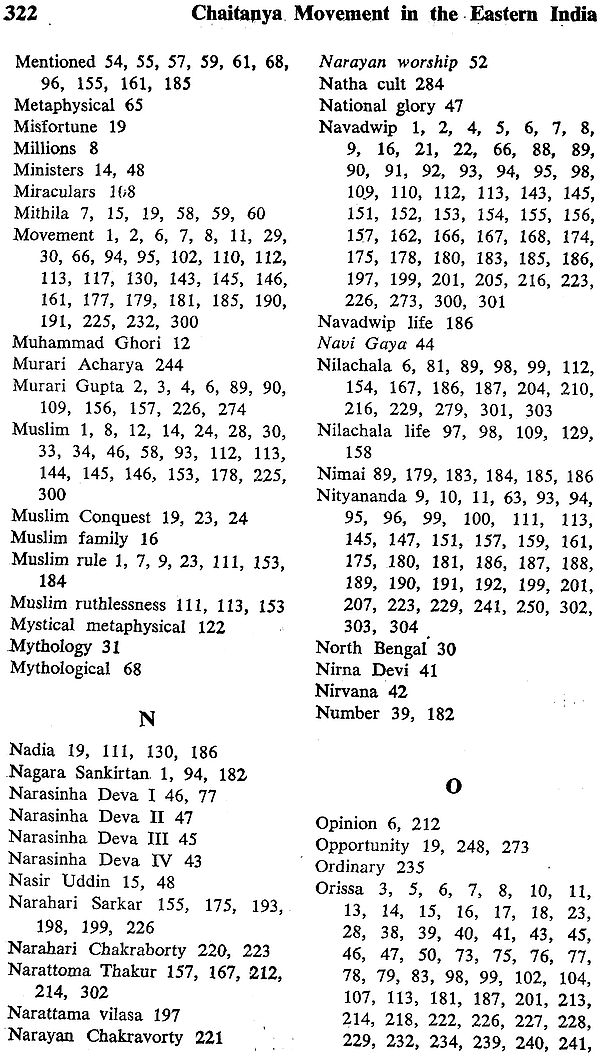
Chaitanya Movement in Eastern India - An Old and Rare Book
Book Specification
| Item Code: | NAF829 |
| Author: | Aloka Lahiri |
| Publisher: | PUNTHI PUSTAK |
| Language: | English |
| Edition: | 1993 |
| ISBN: | 8185094675 |
| Pages: | 346 (10 B/W Illustrations) |
| Cover: | Hardcover |
| Other Details | 8.5 inch X 5.5 inch |
| Weight | 490 gm |
Book Description
Dr. (Smt.) Aloka Lahiri was born at Puri in 1947. She was graduated in 1966 with History Honours and Distinction, received her First Class Master’s Degree in 1968 in History and was awarded Ph.D. Degree in 1987, all from the Utkal University, Bhubaneswar. She started her career as a Lecturer in the Education Department, Government of Orissa in 1968 and was promoted as Reader in 1986. She has been teaching Medieval Indian History, European History, International Relation etc. to the Honours and Post-Graduate students of History of the various Government Colleges of Orissa for the last twenty-five years. She has several research papers which have appeared in the reputed journals. She is married to Dr. S. Mukherji, Professor of Geology, Utkal University, Bhubaneswar.
This book seeks to give a comprehensive history of the Chaitanya movement in Eastern India during the 16th, 17th and 18th centuries. On the basis of evidence, Dr. Aloka Lahiri analyses the background of the movement, the life of Shri Chaitanya and his last days at Puri, and describes in detail the theology of Gaudiya Vaishnavism and the history of the movement after Chaitanya. The book may serve as a good introduction to the study of the Bhakti Movement in Eastern India, and its continuing importance.
Chaitanya was one of the mystic saints of the medieval Bhakti cult of India. The ideologies of the Bhakti movement such as religious tolerance, non-violence universal fraternity, social justice and last but not the least unalloyed devotion to god, were spread by Chaitanya in the entire Eastern India through his socio-religious-movement. These principles are vital to irradicate the present violence and intolerance which is going on in the name of religion, Chaitanya movement in Eastern India was a socio-religious reformation. Being himself a Vaidik Brahmin he supported the cause of the millions of poor illiterate masses of the Eastern India. He had the courage to defy the medieval autocracy of the Kaji. Later on his teachings of universal love mingled with equality was spread over other states of Eastern India.
In the present work the Socio-religious aspects of the movement in the entire Eastern India has been vividly reviewed. It was a very successful mass-movement for the zenefit of the society. Chaitanya was like an angel for the neglected and downtrodden masses of India. Large number of untouchables came within the fold of Chaitanyaism, which is a liberal enlightened religion. Proper understading of Chaitanyaism will remove violence from the present society to a great extent. It is for this reason an indepth study of Chaitanyaism has been undertaken during the present juncture of social unstability.
For this work it has been necessary to spend considerable periods in the National Library, Asiatic Society and also in the Bangiya Sahitya Parisat in Calcutta. The library of Orissa State museum and the Parija library of Utkal University were widely utilized for the purpose of developing the present work. besides, the libraries of Radhakanta Math and Goudiya Vaishnab Math of Puri were also utilized.
I am much thankful to Professor M. N. Das Former Vice Chancellor of Utkal University who suggested me to take up this study and assisted me a lot for the chapterization of this work. I am equally thankful to Professor K. S. Behera of the P. G. Department of History, Utkal University for his valuable guidance e which has enabled me to complete the work. I am also thankful to Late Prof. Prabhat Kumar Mukherjee who has extensively worked on Chaitanya movement in Orissa for his valuable advice during the preparation of the work. I avail the opportunity of thanking my father Late K. D. Lahiri, Former Endowment commissioner of Orissa who had much interest in Chaitanya studies and for his kind encouragement to take up this work on Chaitanya movement. Thanks are also due to U.G.D., New Delhi and Education and youth services Department of Government of Orissa for kindly awarding me a Teacher Fellowship during which greater part of the work has been completed. I am also thankful to the publisher “Punthi Pustak” of Calcutta for kindly taking the responsibility of publishing this work.
Constructive suggestions from the readers are highly welcome.
After the Buddhist movement, Chaitanya movement was the next powerful socio-religious movement in eastern India, which tremendously influenced the socio-cultural and religious life of entire eastern India. It was a mass-movement in which the suffering millions joined. Since the Muslim conquest of Navadwip at the beginning of the 13th century, by Bakhtiyaruddin Khilji, for long three hundred years Bengal was under the Muslim rule. Chaitanya movement was a check on: the ever increasing Muslim dnfluence in eastern India and Bengal specially. Very rightly we can say that the 16th and 17th centuries were the Age of Chaitanya movement. The significance of this movement is that it was not only a religious movement, but to a great extent a socio-cultural revolution in the history of eastern India. It was for the poor, the illiterate and the low- caste people of Bengal. Chaitanya very successfully played the role of a popular socio-religious leader at the need of the time. Not only the Vaishnavas but hundreds and thousands of neglected and helpless Hindus from different religious sects joined Chaitanya's religious camp. It was a highly successful mass-movement against Yavana ruthelessness and against the established Brahmanical orthodoxy. Almost the whole city of Navadwip, except the Shaktas, joined in his historic Nagar Sankirtan against Kazi's order. At the beginning of the movement, he was first the leader of the suffering man- kind, then he was the leader of the small Vaishnava group of Navadwip. Unlike the 19th century Renaissance of Bengal, which was for a few handful of educated leaders of the society, Chaitanya movement was for the entire population of Bengal. It started a new chapter for the history of Bengal and eastern India. This movement gave socio-religious freedom to the non-Brahmins from the yoke of Brahmanical orthodoxy. It was based on the principles of equality, universal fraternity, love and unalloyed devotion to God. Be- cause it was a liberal religion, it also stopped the mass-scale conversion to Islamism. The low-caste degenerated Hindus and Buddhists took shelter within the fold of Chaitanyaism. The Bauls, the Vairagis and Kirtan became the symbol for Bengal's tradition and culture.
The seven major biographies of Chaitanya are the primary sources to know about Chaitanya's life and activities, his teachings and the Gaudiya Vaishnava philosophy. Mainly the contemporary writers wrote these books as the biography or Charitamrita of a great religious personality. Their main aim was the life of Chaitanya and his teachings. Krishnadas Kaviraj described the philosophy of the Vrindavan school. From these religious biographies facts of history have been searched to describe in details the history of Chaitanya movement in eastern India. All the major biographies of Chaitanya were written during the 15th and 16th centuries. And the padavalis in Sanskrit and Bengali were written during his life time or within 80 years of his demise. But all these padavalis are also like the biographies full of miraculous stories.
At the beginning of the movement, none of the medieval biographers, who were all great Viashnava devotees, bothered for the history of the movement. Everybody's aim was to write the life and activities of Chaitanya. To them Chaitanya was the human incarnation of the Supreme God Krishna. So they mostly described the life of Chaitanya in the style of Krishna's life at Vrindavan. Murari Gupta was a classmate of Chaitanya; he also joined the Nagar Sankirtan of Chaitanya. He wrote the first Sanskrit biography of Chaitanya. Sri Krishna Chaitanya Chari tam rita, popularly known as Murari's Kadcha. Mainly he wrote the life of Chaitanya at Navadwip till the year 1513. He described the Navadwip lita of Chaitanya. During the early days at Navadwip, he was a close companion of Chaitanya. Chaitanya went into trance for the first time in Murari's house at Navadwip. His work seems to have completed within a decade of Chaitanya's demise. The last portions of the book are later interpolations. This problem is to be found in almost every old text. Yet it is an authentic book to know the life of Chaitanya at Navadwip, though it is full of miraculous stories. He described Chaitanya as four handed Vishnu.
Kavi Karnapura was born about the year 1524. His real name is Paramananda Sen and he was the youngest son of Sivananda Sen. Sivananda was a reputed associate of Chaitanya and a contemporary padakarta. Kavi Karnapura was a prolific writer. At the age of sixteen he wrote hisKavya, Sri Chaitanya Charitamrita Mahakavya, which ended in the year 1542. He followed the ideal of Murari Gupta upto the 11th canto. This work gives a complete account of Chaitanya's life. His second work is the ten-act drama, Sri Chaitanya Chandrodayam N atakam which was completed in the year 1572. It gives in details Chaitanya's life at Puri, his last days and his association with the devotees of Orissa. It is a more mature work, but modelled on the Prabodha Chandrodayam. The subsequent biographers utilized both the 'works of him. His third work is Gaura Ganoddesa dipika which he wrote in the year 1576. This book identified Chaitanya's associates with their counterparts in Krishna's Vraialila. He differed with the ideology of Vrindavan-school. 'The greatest mistake of Kavi Karnapura is that he included Chaitanya in the Madhva-sect. Yet his books are reliable. He also differed from the opinions of Swarupa Damodar. He bad the courage to differ from such a close associate of Chaitanya, because his father was also a very close associate of Chaitanya. Prabodhananda Saraswati's Sanskrit poems entitled, Chaitanya Chandramrita, described the love-sickness of Chaitanya at Puri. In Stavamala, Rupa Goswami wrote poems on Chaitanya's love-sickness at the end of his life; similarly Raghunath Das Goswami, in his Stavavali wrote Poems on the love-sickness of Chaitanya before his passing away. Contemporary padavalis on Chaitanya are great wealth as source materials, yet the facts given in them are conflicting. These are mainly devotional lyrics on Chaitanya and their main value is literary.
Much better materials are the five important biographies of Chaitanya. From historical point of view, Lochana Das's Sri Chaitanya Mangal is not so important. But we are to get the grain leaving the chaffs. So we cannot completely ignore Lochana's Sri Chaitanya Mangal. Lochana Das was a contemporary of Jayananda, he was born in 1523. In the last chapter of his Chaitanya Mangal he described that Chaitanya disappeared in the image of J agannath in the Tota: But in which Tota or garden that is not clear. The date of Lochana Das's book is not known. But his preceptor, Nara- hari Sarkar was a contemporary poet and Chaitanya's associate at Navadwip. May be the book was written sometimes between 1550 to 1612. Brindaban Das's Chaitanya Bhagavata is the earliest Bengali biography of Chaitanya. It was written at the command of Nityananda in between the years 1538 to 1550. This is a very forth-right biography written by a devoted Vaishnava whose mother had come in contact with Chaitanya in her infancy. This book is also. reliable one as far as Chaitanya's life and activities' at Navadwip and the early history of Chaitanya Movement at Navadwip are concerned. It was written to establish 'the ideologies of Navadwip-school. But the Antya Khanda of this biography ends abruptly. Brindaban Das was born after Chaitanya's last visit to Navadwip, tIe 'got the informations about Chaitanya . from his mother Narayani and his preceptor Nityananda, This is the most popular biography of Chaitanya in Bengali. Jayananda was born aboutTo l O, He had written the book Chaitanya Mangal between 1548-1560. This biography throws some new lights on Chaitanya's life. His father Subudhi Misra was a disciple of Chaitanya, his mother, Rodani Devi was a disciple of Nityananda and he himself was the disciple of Gadadhar Pandit, one of the intimate companions of Chaitanya. With the permission of his' preceptor, he had' written this book. Historians like R. C . Majumdar, R. D. Banerjee accepted many of the information of Jayananda's Chaitanya Mangal. Even B. B. Majumdar accepted the description of Jayananda, for example Chaitanya died at Tota Gopinath. Krishnadas Kaviraj's Sri Chaitanya Charitamrita is a massive, biography of Chaitanya. The author described the life and activities, teachings and philosophy of Vrindavan-school most vividly in this book. So it is a religious text for the Gaudiya Vaishnavas. He started' composing this book in 1612 and finished in 1615. Krishna- das Kaviraj considerably utilized the books of Murari Gupta- and Swarupa Damodara. Now the Kadcha of Swarupa Damo- dara is lost. He also utilized books of Kavi Karnapura, Brindaban Das and last but not least, the personal reminiscences of the Vrindavan Goswamis who advised him to write this book as the supplement to Brindaban Das s Chaitansa Bhagavat, because in Brindaban Das's book, the last part of Chaitanya's life at Puri is very brief. So to complete the work of Brindaban Das he wrote this book. It is not only the biography but also an epitome of Gaudiya Vaishnava philosophy. Specially, the philosophy of Vrindavan-school. It is written to bring a compromise between Vrindavan school and Navadwip school. It has been written in Bengali to spread the philosophy of Vrindavan school in Bengal. It is highly popular to all the Gaudiya Vaishnavas of Bengal, Orissa and Vrindavan. During the medieval days, specially during the time of Brindaban Das and Krishnadas Kaviraj, writing of history, as we see now-a-days, was practically unknown in India. So these two highly successful authors of Chaitanya's biographies should be given credit for this achievement. Govinda Das's Kadcha is a controversial book. The authenticity of this Kadcha has been violently disputed as it has been accepted. Chaitanya, during his tour to south India took a servant with him, called Govinda and this Govinda quite possibly wrote a short account of their pilgrimage to south.
To write about Chaitanya's life and activities, the age of Chaitanya and the brief history of his associates safely We can depend upon the seven major biographies, leaving the miraculous stories. To know the last 18 years of Chaitanya's life at Puri, Oriya sources are essential. To write about the history of Chaitanya movement, the padavalis of Basudeva Ghosh, Narahari, Bansi Badan and Sivananda Sen are important. About the later development of Chaitanyaism in Bengal and Orissa, Prema Vilasa, Karnananda, Anuragavalli, Bhakti Ratnakar are important. Though the seven major biographies of Chaitanya and the padavalis of the contemporary poets only described the life and activities of Chaitanya and about his close associates of Navadwip and Puri, yet from these books and poems we get in a scattered way some glimpses of the Chaitanya movement in eastern India.
Most of the Bengali and English books on Chaitanya mainly described the movement in Bengal. Though for long eighteen years of his monastic life, Chaitanya was at Puri,yet Chaitanya movement in Orissa is neglected by the important writers. Not only Chaitanya movement in Orissa, but also the last days of Chaitanya at Puri is not in details in most of the Bengali and English books. So in this thesisefforts have been made to write a brief history of Chaitanya movement in eastern India in a balanced way. B. B. Majum- dar's book in Bengali, Chaitanya Chariter Upadan, is a massive book on Chaitanya's life and activities, on his associates. and he has given a review of the primary books on Chaitanya. Yet he neglected the development of Chaitanya movement in Orissa. Because he followed the ideal of Murari Gupta, Kavi Karnapura and the contemporary padavalis, the historical Chaitanya which Brindaban Das, in his Chaitanya Bhagavata described was eclipsed by Nagarabadi imaginative, unreal Chaitanya. He had neglected the important points like Chaitanya's relation with the Pancha Sakhas of Orissa. M. T. Kennedy's book, Chaitanya Movement, is also a good book as far as Chaitanya movement in Bengal and Vrindavan is concerned. S. K. Dey's book on the philosophy of Gaudiya Vaishnavism is a monumental work. He elaborately des- cribed the works of the 6 Goswamis of Vrindavan. In the same way, R. G. Nath's Gaudiya Vaishnava Darsan, is a highly successful religious and philosophical book. He described the teachings and Darsan of Gaudiya Vaishnavism, A. K. Majumdar's book on Chaitanya's doctrine and life, described his life and activities at Navadwip and Nilachala. He also described the origin, growth and development of Vaishnavism as a whole. He described the socio-religious condition of Bengal before the birth of Chaitanya. But he- had not given the later history of Chaitanya movement in eastern India. G. S. Roy Chaudhury, in his book Bangla Charit Granthe Sri Chaitanya, described the social aspect of Chaitanya movement. In his opinion, Chaitanya was a socio- religious reformer and he started a social movement in Navadwip. He neglected the spiritual force of the movement. S. K. Dey's opinion is different. In - the opinion of S. K. Dey, Chaitanya movement was a religious movement and Chaitanya was not' a social reformer. He had no plan to spread his movement as a reformer. P. Mukherjee followed mainly B. B. Majumdar and he had not taken into account the recent biographies of Chaitanya written by the modern scholars. R. N. Maiti, in his book Chaitanya Parikar, gave in details the life and activities of all the major and minor associates of Chaitanya. H. C. Sarkar also in his biography of Chaitanya neglected the history of the movement in Assam and Orissa. H. D. Chakravarty, in his book Asomardha Sri Krishna Chaitanya, discarded the old views of B. B. Majumdar. He supported the Bengali biographies. N. P. Nath, in his biography of Narattoma Das Thakur, described in details the later development of Chaitanya movement in Bengal by the three great Vaishnava leaders of the later period. Historian like R. D. Banerjee, R. C. Majumdar, H. K. Mahtab, supported some of the informations of Jayananda. For example R. C. Majumdar, in his history of Bengal, Vol. II, accepted Jayananda's opinion that Chaitanya's demise took place at Tota Gopinath at the presence of Gadadhar Pandit. He also supported the description of Brindaban Das and Jayananda about the socio-religious condition of Bengal before the advent of Chaitanya. Sir J. N. Sarkar wrote about the life and teachings of Chaitanya and his pilgrimage to south. H. K. Mahtab accepted Jayananda's opinion that the ancestral home of Chaitanya was at Jajpur in Cuttack district of Orissa. But most of the secondary books neglected the history of Chaitanya movement in eastern India as a whole. So the aim of this thesis is to give a comprehensive history of Chaitanya movement in eastern India, from the beginning till the 18th century.
The entire thesis is divided into five chapters. In Chapter I a brief account of the socio-religious condition of eastern India before the advent of Chaitanya has been given. Because of Muslim rule and Yavana ruthelessness, Bengal was passing through the Dark Age and for a clear understanding of this condition, briefly the political history of eastern India specially Bengal, Mithila and Orissa during the 14th, 15th and early 16th centuries has been discussed. Navadwip, before the birth of Chaitanya, was a famous centre of Sanskrit learning. The main religion of the Brahmins was Shaktaism.Shaktas were against the Vaishnavas. Brahmanical orthodoxy was the great burden for the society. To avoid Brahmanical torture, large number of low-caste Hindus were welcoming Islam. Religious conversion was in a high rate in Bengal. Society was full of narrowness and superstition. Casteism was very strong among the Brahmins. Assam was a strong seat of tantricism. In Assam human sacrifice was very common till the recent past. In the villages and rural areas of Orissa, most of the people were Buddhists. Saivism, Vaishnavism and Jagannath Dharma were in the cities of Orissa. In Assam, Bengal and also in Orissa, religious persecution by the kings is evident. On the whole, the socio-religious condition of entire eastern India during the medieval age was extremely miserable. In Bengal Muslim sultans continued religious persecution over the Brahmins and the Hindus, in Orissa the kings sometimes followed religious persecution over the Buddhist. In Assam the Shakta kings continued royal persecution over the Vaishnavas. During the medieval days of Bengal, in the city of Navadwip, which was the citadel of Brahmanical orthodoxy, Chaitanya was to bring light in the society. He very successfully played the role of a rising popular leader of the millions of mute population of Bengal. He brought a change in the socio-religious history of Bengal after 300 years of inhuma suffering, from the fall of Navadwip. In this chapter not only the socio-religious condition of eastern India during the medieval age, but also a brief account of pre-Chaitanya Vaishnavism in eastern India, has been discussed. Mainly, in which form Vaishnavism was in eastern India, before the beginning of Chaitanya movement or before Chaitanya spread his Neo- Vaishnavism, has been discussed critically.
In Chapter II, the life and activities of this great religious personality who had all the Godly qualities have been given. Here for this chapter, all the seven major biographies of Chaitanya have been studied. Discarding the supernatural stories, the facts of the natural life of this extraordinary saint have been collected, such as his life at Navadwip, beginning of the Chaitanya movement, the change of his mind and ultimately he took sannyasa at Katowa. Then the last 18 years of his life at Puri, his association with the devotees of Pun an,d his demise. As far as possible, the real nature and personality of Chaitanya has been given. He was a socia-religious leader at Navadwip. In his historic Nagar Sankirtan, not only Vaishnavas of Navadwip, but all the citizens of Navadwip, except the Shaktas, joined in it. On that night he was not only the leader of the small Vaishnava Group of Navadwip, but he represented the entire, neglected mass of Bengal. It was a revolution against the Muslim rule and the established society. It was not only a religious movement, but equally a Social revolution. Chaitanya was the leader of this revolution. He demanded justice and equality, liberty and human right from the Kazi. His courage, his personality, his determination immediately made him the most popular man in whole of Navadwip.
Chapter III is a technical and philosophical chapter. In this chapter, the teachings of Chaitanya and the philosophy of Gaudiya Vaishnavism mainly following the original texts of the Vrindavan Goswamis, have been elaborately discussed. Chaitanya's religion is a new sect of Vaishnavism like the previous four other schools of Vaishnavism. It is an original sect and not the sub-branch of Madhvaism or Nimbarkite sect. It is based on Achintya Vedaved Bad. His new school of Vaishnavism deeply influenced the society and religion of eastern India. The present Gaudiya Vaishnavism is the happy synthesis of the two schools, Navadwip school and Vrindavan school. Nityananda and Advaita were the leaders of Nava- dwip school and the six Goswamis were the leaders of Vrindavan school. Navadwip leaders gave emphasis on the social aspect of the religion. Nityananda started a radical, social revolution in Bengal. After him, his son, Virachandra continued it. Nityananda and Virachandra accepted large number of degenerated Buddhists within the fold of Chaitanyaism. So they indirectly stopped conversion to Islam. Indirectly, Chaitanyaism saved Bengal from the total influence of Islam. The contribution of the Vrindavan school is that on the fundamental teachings of Chaitanya, the six Goswamis constructed the huge superstructure of Gaudiya Vaishnava philosophy. They set the rituals, customs and the principles of the sect. They systematised the cult of the sect by codifying the rules for the sect. The later leaders of this school are Narattama Das, Srinivasa Acharya, Shyamananda Das, Vishvanath Chakravarty and Valadeva Vidyavusan.
Chapter IV deals with the growth and spread of Chaitanyaism in eastern India during his lifetime and after his demise, till the 18th century. Nityananda, Advaita, Virachandra continued the movement in Bengal. It was highly' successful there. There it took the shape of a social movement. In Orissa, during the lifetime of Chaitanya, it was not so wide but after his demise, his disciples spread it in the whole of Orissa. Shyamananda and Rasikananda in the 17th century spread it in Orissa, which we can know from the books Rasik Mangal and Pravu Shyamananda. In Assam, Gaudiya Vaishnavism was spread by two of the disciples of Nityananda. Whole of Manipur became a strong centre of Gaudiya Vaishnavism. Vrindavan became the seat of Gaudiya- Vaishnava-learning.
Chapter V is Chaitanya and Orissa. It is a special study on Chaitanya's relation with Orissa, Jagannath and the Oriya devotees. In this chapter the possibility of Chaitanya's ancestral house at Jajpur in Cuttack district of Orissa has been discussed. All the primary and secondary biographers neglected Orissa. Though for long 18 years of his monastic life he spent at Puri, yet most of the books only described his- love-sickness and Gaudiya Vaishnava philosophy. Chaitanya preferred Orissa in lieu of Vrindavan, because Jajpur was his ancestral home, he had an inseparable bond with Jagannath, to him Jagannath was the Krishna of Dwaraka, Sanatan Goswami described Jagannath as' Chaitanya Ballava. During Chaitanya's lifetime, the devotees of Orissa regarded him as the living Jagannath. He had close association with the five Vaishnava friends of Orissa, though their religion was different from Gaudiya Vaishnavism. King Pratapa Rudra was a great devotee of Chaitanya. In many of the Oriya books, Chaitanya and his Gaudiya associates were mentioned, specially Achyutananda in his Sunya Sanhita, described that Chaitanya had close' association with the Pancha Sakhas of Orissa. The later Vaishnava literature of Orissa was deeply influenced by. Gaudiya Vaishnavism. Ultimately after his long stay at Pun, he had his demise at Tota Gopinath in the presence of Gadadhar Pandit. A large number of Oriya Primary and Secondary sources have been studied to write this Chapter Which is a critical study on Chaitanya's life and activities in Orissa.
Chaitanya movement was highly popular in whole of Bengal, Orissa, Assam and Manipur, because it was based on the principles of socio-religious equality. Because of the concept of equality, the common mass of eastern India supported it. Chaitanyaism is based on universal love, humanism, socialism and complete surrender to God through pure unalloyed devotion. Yavana Haridas was an important leader of the Chaitanya-cult. It was against Brahmanical orthodoxy. It started in Bengal and Orissa, as a radical, social revolution. In Bengal, Nityananda was the leader to continue this ideal. In Orissa, the religious movement which was started by Sarala Das and the Pancha Sakhas against Brahmanical orthodoxy was intensified by Chaitanya movement. Mankind has been given an exalted position in this cult. The dream of the poet Chandidas is fulfilled in Chaitanya movement. It carries the message of Universal love and humanism. "Chandalopi Dwiia Srestha Harl-bhakti parayana", is the ideal of Chaitanya movement. Chaitanya movement is a part of the medieval Bhakti movement of India. Kabir, Nanak, Chaitanya were the three important leaders of medieval Bhakti movement.
| Foreword | v | |
| Preface | vii | |
| Introduction | 1 | |
| Chapter I: | Background Of The Movement | 12 |
| A. | Socio-Religious condition of Eastern India before Chaitanya | |
| B. | Pre-Chaitanya Vaishnavism in Eastern India | |
| Chapter II: | The Life Of Chaitanya | 88 |
| A. | Chaitanya at Navadwip | |
| B. | Chaitanya at Nilachala | |
| C. | Historicity of Chaitanya's Character | |
| Chapter III: | Chaitanyaism | 117 |
| A. | Chaitanya's teachings and contributions | |
| A.1. Religious | ||
| A.2. Social | ||
| A.3. Literary Aspects | ||
| B. | Different Chaitanya Schools | |
| B.1. Navadwip School | ||
| B.2. Vrindaban School | ||
| Chapter IV: | Growth Of Chaitanyaism During His Lifetime and After His Demise | 174 |
| A. | Bengal | |
| B. | Orissa | |
| C. | Assam | |
| Chapter V: | Chaitanya And Orissa | 272 |
| A. | Chaitanya's Ancestral home at Jajpur, Cuttack district | |
| B. | Chaitanya and Jagannath | |
| C. | Chaitanya and Pancha Sakhas of Orissa | |
| D. | Chaitanya and Oriya Literature | |
| E. | Chaitanya's last days at Nilachala and controversies regarding his demise | |
| Conclusion | 300 | |
| Bibliography | 305 | |
| Index | 316 |
